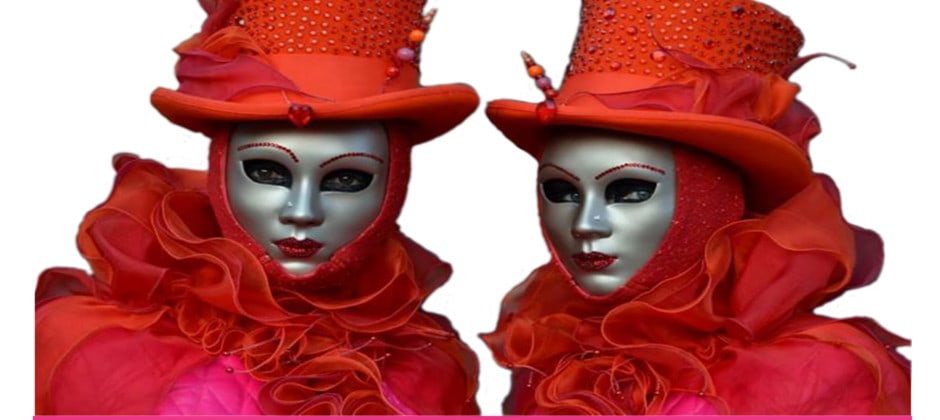
Venice Carnival
The Venice Carnival was always one of the most popular feasts in the city, and records documenting this event go back as far as the eleventh century.
Ready to party?
Book now your Carnival Party at Hotel Carlton on the Grand Canal!
History of the Venice Carnival
The meaning of carnival dates back to a Christian interpretation of the Latin “carne levare” or carnelevarium, which means “to remove meat. As a religious formality Ash Wednesday obliged people to fast and as a result people needed to use up meat, butter and eggs. This became an excuse for a party that echoed pagan festivities.
The Venice Carnival was always one of the most popular feasts in the city, and records documenting this event go back as far as the eleventh century.
The Venice Carnival tradition started in 1162 with the celebration of the victory of Doge Vitale Michele II over the Patriarch Ulrico of Aquileia. The tradition began with slaughtering of a bull and 12 pigs in the Piazza San Marco to commemorate the victory. This celebration gradually grew and in 1268 the first use of masks for the Carnival was mentioned in documents.
From the mid-1400s until the endof 1500s, Carnival festivities began to be regulated due to the excessive misbehavior and transgressions of the masked crowds. Several Popes tried to bring the Carnival within proper religious limits, but they weren’t able to influence Venice.
It was characterized by its magnificent masquerades, masked balls and feast, rather than by street processions and parades which were common elsewhere
The extravaganza of carnival merrymaking culminated in the 1700s. The festivities lasted for nearly 6 months and attracted tourism from all over Europe. The Carnival began the first Sunday in October and continued until Christmas. After a short break, it picked up again from January 6 (Epiphany) and lasted until midnight on Shrove Tuesday, the day before Ash Wednesday. During these days, Venice was known as the European center of libertinism a center of gambling and courtesans.
In 1797 the Napoleonic invasion brought an end to the fun and games. Napoleon abolished a thousand year old Republic as well as the Carnival to undermine the city’s cultural identity and keep control over its citizens. Then, by the Treaty of Campo Formio, he ceded the city of Venice to Austria.
In the 1800s, during Austrian rule, masks were banned. Venice was no longer a city with an annual Carnival tradition. Occasional Carnivals were held on and off until the 1930s, at which point Mussolini officially banned them.
In 1979, the municipality successfully revived the tradition of the Venice Carnival, reestablishing Venice as the world’s finest carnival destination.
Nowadays the heavily subsidized celebrations draw revelers from all over the world.
Venice Carnival Recipes
…And it’s not Carnival in Venice without good food and wine!
Galani and Frittelle are the main protagonists of the colourful Venice Carnival.
The frittelle (fritole in Venetian dialect) have represented the traditional Carnival dessert in Venice, since the Renaissance.
Carnival was mostly celebrated outdoors; there was a festive atmosphere throughout the City, among campi and campielli, in which masked commoners and aristocrats mingled with dancers and charlatans…
In order to meet the desires of as many people as possible food had to be prepared quickly and in large quantities. And what else could serve the purpose if not frying fritters? Here come the Venetian “fritoleri“, so dear to Carlo Goldoni (Venice 1707- Paris 1793).
In XVII Century the fritoleri even formed a corporation. They were a total of 70 and to each one was assigned a fixed place called casello, a square shaped wooden shack. The corporation of fritoleri was a family craft that passed from father to son. The corporation remained active until the fall of the Venetian Republic but only in the late XIX century the art of fritoleri came to an end.
The Carnival frittelle recipe has the greatest number of variations: cream fritole, sabayon fritole and even fritole filled with Nutella… but the original fritole Venexiane (frittelle Veneziane) do not have any additional ingredients that alter the original flavour and we can assure you that they are delicious!
Fritole Venexiane Recipe:
|
|
Wash the raisins and dry with a clean cloth. Dissolve the yeast in warm milk and melt the butter in a bain-marie. In a large bowl put 50g of sugar and knead with the eggs, add the melted butter, yeast, raisins, pine nuts, lemon zest and rum and stir until the dough is smooth. Slowly add the flour and a pinch of salt. Work the mixture vigorously and let it rest for an hour until it has doubled in volume. Heat the oil well and, using a spoon to give them shape, fry the Frittelle di Carnevale until they are puffed and golden. Drain on absorbent paper and serve sprinkled with the remaining sugar.
——–
Among the Carnival cakes, galani are the easiest to make at home. Its recipe dates back to Romans who, during the Spring Festival, with the same mixture used to make lasagna, prepared cakes very similar to Galani, fried in pork fat and sprinkled with sugar.
Galani recipe
|
|
Mix into a smooth paste all the ingredients, being careful not to create lumps.
Roll out the dough into a thin sheet. Leave to rest and then, with the help of a rolling pin, make the dough as thin as possible. Cut into diamond shapes with small cuts in the middle and fry the carnival galani in hot oil. Drain on paper towels and sprinkle with powdered sugar.
————





 HOTEL CARLTON CAPRI
HOTEL CARLTON CAPRI LA CUPOLA RESTAURANT
LA CUPOLA RESTAURANT TOP OF THE CARLTON SKY LOUNGE
TOP OF THE CARLTON SKY LOUNGE HOTEL CARLTON ON THE GRAND CANAL
HOTEL CARLTON ON THE GRAND CANAL
















